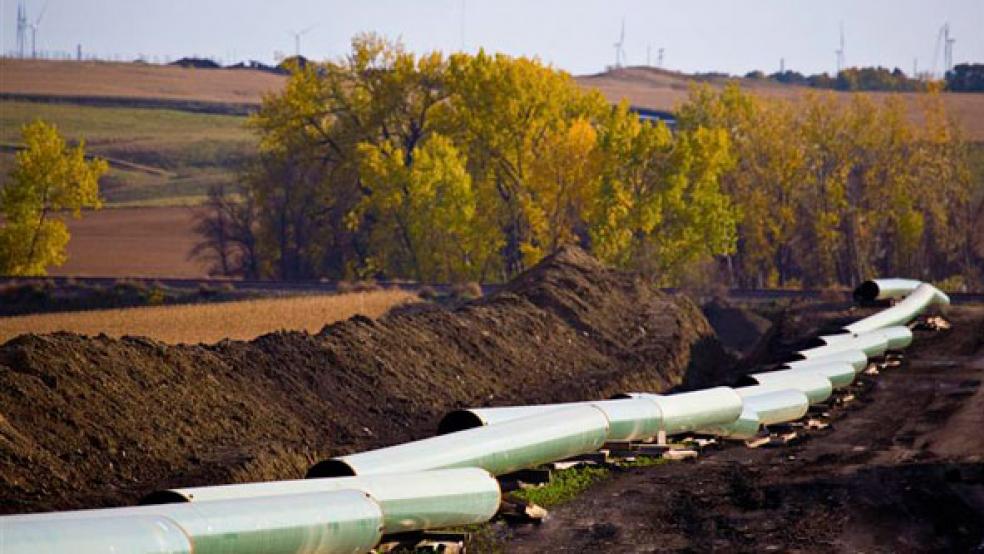What if they voted for a pipeline but nobody came?
As Congress rushes to approve the long-delayed Keystone XL pipeline, it is questionable whether or not the project will make as much of a difference as proponents expect. Since June, crude oil has declined by 28 percent, pushing the price that oil from new wells in Canada may command below what the expected cost will be to produce it.
The so-called "heavy oil" extracted from sand in Alberta, which the proposed pipeline would carry to Nebraska, en route to refineries on the Gulf Coast, will cost between $85 and $110 to produce, depending on which drilling technology is used, according to a report in July by the Canadian Energy Research Institute, a nonprofit whose work is often cited by Keystone proponents. West Texas Intermediate crude oil traded today at $76.67.
"Anything not under construction [is] at risk of being delayed or canceled altogether," said Dinara Millington, vice president for research at Calgary-based CERI. Her cost estimates include the price of drilling new wells, meaning that existing wells that have already been paid for can continue to pump oil profitably, she said.
Related: Keystone Pipeline-Job Creator or Environmental Menace?
CERI' s analysis squares with the views of other experts, who have pointed to low prices as a sign that economic facts, at least for now, don't match political rhetoric coming from Washington, where Keystone has been a goal for both Republicans and for Senate Democrats from oil-producing states.
One of the latter, Louisiana Sen. Mary Landrieu, is in a tough reelection fight, which went to a runoff set for Dec. 6 after no candidate won a majority of the initial vote last week. Senate Majority Leader Harry Reid yesterday set a vote on Keystone for next week after Landrieu called for a vote in the Senate, which has refused to take up House of Representatives-approved legislation authorizing the pipeline.
Oil sands are among the most expensive sources of oil, costing an average of $75 to $80 a barrel to produce, Norwegian energy-consulting firm Rystad Energy said in June.
"I would think that in order for new drilling projects to be capitalized and economical, the price of oil would need to be around $85 to $90," Moody's Analytics energy economist Chris Lafakis said.
The situation is broadly similar to that faced by an earlier proposal to build a natural-gas pipeline from Alaska to the Midwest, Lafakis said. After being approved by then-Alaska Gov. Sarah Palin in 2007, the pipeline was never built, because newly discovered supplies of gas in the Lower 48 states pushed gas prices down by about two-thirds.
"If oil were to stay as cheap as it is right now, you might very well get that Palin pipeline scenario," Lafakis said.
One major oil producer in Alberta said its reserves can be brought to market for between $35 and $65 per barrel, a level Millington confirmed that some existing wells can achieve. And futures markets for oil are still pointing to a longer-term price of $85 to $90 a barrel, said Reg Curren, a spokesman for Cenovus Energy (CVE).
"For the intermediate term, you would need that price to keep encouraging production," Curren said.
Shawn Howard, a spokesman for Keystone XL owner TransCanada, referred questions about future drilling plans to oil producers such as Cenovus.
Transcanada's revenue from the pipeline will come from tolls charged to carry the oil, which have not been publicly disclosed, rather than from the oil itself, he said.
How long oil prices will stay low is the big question mark in the pipeline's viability.
West Texas Intermediate prices will fall to $70 a barrel by the second quarter of 2015, Goldman Sachs forecast last month. The U.S. Energy Information Administration predicted Wednesday that the benchmark price of U.S. crude oil will average $77.75 a barrel next year. That's down from a previous forecast of close to $95.
Demand has been running slightly lower than expected in 2014, which will persist into early next year, the International Energy Agency said, blaming reduced expectations for global economic growth. Supply has risen by more than 900,000 barrels a day in September alone and nearly 3 million barrels a day in the last year, about three times as much as the expected improvement in demand.
In addition to surging production in the U.S., which has boosted oil output by more than 60 percent since 2008, the IEA said OPEC crude oil output is rising as production in Libya and Iraq recovers from political disruption.
Related: Keystone Pipeline Debate Can End with New Tech
The global oil market is about 92.4 million barrels of oil per day, the agency said.
Saudi Arabia has helped push prices lower by declining to reduce production in the wake of the price declines. The near-term outlook for oil and for Keystone may depend on the OPEC summit set for Nov. 27, Millington said.
"After Nov. 27, we'll have a better idea of what prices will be,'' she said.
This piece originally appeared at CNBC.
Read more from CNBC:




